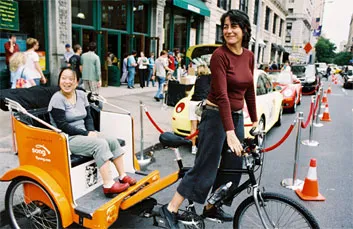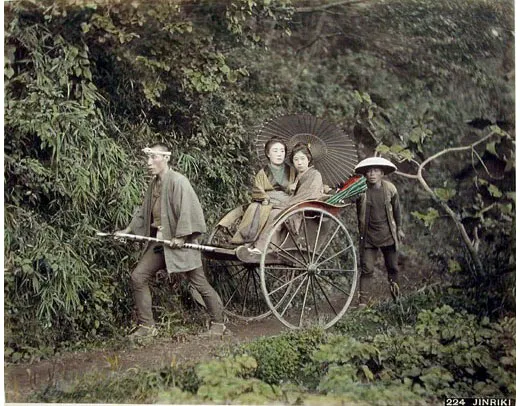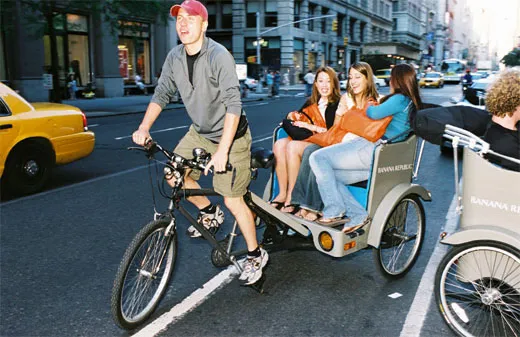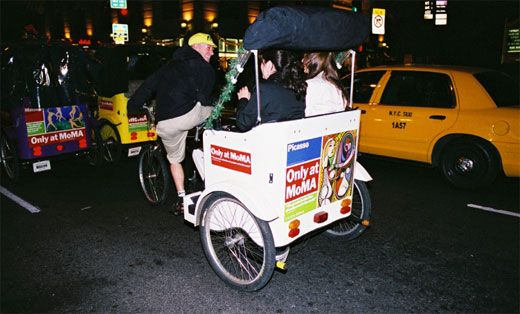Rickshaws Reinvented
The ancient transportation takes a modern turn
/https://tf-cmsv2-smithsonianmag-media.s3.amazonaws.com/filer/richshaw_trio.jpg)
From London to Anchorage, New York to Hanoi, it seems as if people everywhere are catching a ride on rickshaws. Surprised? Thought that those human-pulled carts, century-old symbols of exploitation and poverty, were obsolete?
As of last December, they are—at least in the stereotypical form of a man in rags and a straw hat running barefoot through crowded Asian streets, drawing a cart carrying one or two obviously better-off passengers. That's when the government of West Bengal banned man-pulled rickshaws in Kolkata (formerly known as Calcutta)—the last place in the world where they were in widespread use. Explaining the ban at a press conference, Kolkata's Mayor Bikash Ranjan Bhattacharya said, "We can't imagine one man sweating and straining to pull another man." An estimated 18,000 rickshaw drivers have since taken to the streets to protest what they see as the removal of their livelihoods.
Though traditional rickshaws might have made their last trips, the concept of one person using his muscle to pull a cab with people or goods remains very much alive. Companies with names like "Cleverchimp Rickshaw" and "Orient Express Rickshaw," have sprung up across Europe, the Middle East, Asia and the Americas, offering an environmentally friendly way to shop, avoid big city traffic, sightsee, deliver packages—even return home after a night on the town. Several dozen companies operate in the United States alone.
Modern-day rickshaws vary in style from country to country, use bicycle pedals (often assisted by small motors), are primarily three-wheeled and can be canopied or completely enclosed. A few are resplendent in neon colors; some look like space vehicles, others show off the handiwork of their cultures, still others are as covered in advertisements as NASCAR entries. Universally known as rickshaws, they're called velo-taxis in most of Continental Europe, cyclos in Cambodia and pedicabs in Britain and the United States.
While they might carry the same genes, these new-age old-school vehicles differ substantially from their infamous ancestor—a two-wheeled cart with a collapsible hood and two long shafts.
"When technology met the rickshaw, everything changed," says Peter Meitzler of New York's Manhattan Rickshaw Company. "The modern pedicabs have hydraulic brakes, suspension, complete lighting systems, seat belts, full weather canopies, steel frames and fiberglass bodies."
Meitzler, whose title Person in Charge betrays his innovative spirit, is one of literally hundreds of entrepreneurs around the world hooked on pedal power as an alternative to gas guzzling. "You experience the urban environment differently when you're riding in a rickshaw," he says. He used "rickshaw" in the company name because it was internationally known.
The term is actually a shortened form of the Japanese word jinrikisha; literally, human-powered vehicle. There are conflicting theories about its inventor—the most prevalent is that Jonathan Scobie, an American missionary in Japan, designed it in 1869 to transport his invalid wife—but there is no question that Japan was the first country to use it widely. By the late 1870s, the rickshaw was that nation's main mode of transport, with an estimated 40,000 of them operating in Tokyo alone.
From there it quickly spread to other Asian countries. Peasants migrating to cities in search of work saw in rickshaw-pulling a quick, if exhausting, way to make a living. Several books and films, notably City of Joy, based in Kolkata, and Rickshaw Boy, the first Chinese Communist movie shown in American theaters, have chronicled the unenviable lives of rickshaw pullers, the very image of the downtrodden.
Historically, most rickshaws were rented, and the drivers had to work 17- to 18-hour days to survive. They ran in a single file at about five miles an hour through the mud and grime of teaming streets, with the front driver calling out warnings of any road hazards ahead. The rickshaw was not only their livelihood; it was also where they kept their few belongings, where they slept and where they ate.
Regarding them as a capitalist evil and a sign of China's subjugation to the West, the Communists banned rickshaws shortly after taking over that country in 1949.
All across Asia, pedals replaced the shafts and the pulled rickshaws became reserved as a unique treat for travelers visiting tourist spots. Today, they often serve as backdrops for posed souvenir photos, happy reminders of an unhappy past.
Planning Your Next Trip?
Explore great travel deals
Smithsonian magazine participates in affiliate link advertising programs. If you purchase an item through these links, we receive a commission.




